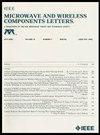Silicon Photonic Radar Receiver IC for mm-Wave Large Aperture MIMO Radar Using Optical Clock Distribution
IF 3.3
2区 工程技术
Q2 ENGINEERING, ELECTRICAL & ELECTRONIC
引用次数: 4
Abstract
A silicon photonics millimeter-wave (mm-wave) radar receiver (RX) integrated circuit (IC) for a multiple-input–multiple-output (MIMO) imaging radar is presented. Optical clock distributed over fiber enables coherent operation of several transceiver frontends for large apertures and finer angular resolution in the MIMO imaging radars. All electronic and photonic components needed to receive the optical clock signal, the electronic radio frequency (RF) signal, and the in-phase quadrature (IQ) downconvertion to the baseband is integrated in the RX frontend IC. The RX chip supports optical clock signals at 1310- and 1550-nm optical wavelengths. The chip is implemented in IHPs pre-production photonic 250-nm SiGe BiCMOS technology. At an intermediate frequency (IF) of 1 MHz, the measured conversion gain (CG) is 6.95 dB at an RF of 66 GHz and −11.18 dB at an RF of 77 GHz from −5-dBm optical modulation amplitude (OMA) and −13-dBm RF power. The RX IC dissipates 770 mW and is operated with a single 3.6-V power supply. For the realization of an optical receive path, an off-chip lithium niobate (LiNbO3) Mach–Zehnder modulator (MZM) was used. The optical receive path achieves a saturated OMA of −6 dBm at an RF of 77 GHz and at an IF of 1 MHz.基于光时钟分布的毫米波大孔径MIMO雷达用硅光子雷达接收机集成电路
介绍了一种用于多输入多输出成像雷达的硅光子毫米波雷达接收机集成电路。分布在光纤上的光学时钟使MIMO成像雷达中的大孔径和更精细的角分辨率的几个收发器前端能够相干操作。接收光时钟信号、电子射频(RF)信号和到基带的同相正交(IQ)下变频所需的所有电子和光子组件都集成在RX前端IC中。RX芯片支持1310和1550 nm光波长的光时钟信号。该芯片采用IHPs预生产的250nm SiGe-BiCMOS光子技术实现。在1 MHz的中频(IF)下,从−5-dBm光调制幅度(OMA)和−13 dBm RF功率,在66 GHz的RF下测得的转换增益(CG)为6.95 dB,在77 GHz的RF上测得的转化增益为−11.18 dB。RX IC消耗770mW,并使用单个3.6V电源进行操作。为了实现光接收路径,使用了片外铌酸锂(LiNbO3)马赫-曾德尔调制器(MZM)。光接收路径在77 GHz的RF和1 MHz的IF下实现−6 dBm的饱和OMA。
本文章由计算机程序翻译,如有差异,请以英文原文为准。
求助全文
约1分钟内获得全文
求助全文
来源期刊

IEEE Microwave and Wireless Components Letters
工程技术-工程:电子与电气
自引率
13.30%
发文量
376
审稿时长
3.0 months
期刊介绍:
The IEEE Microwave and Wireless Components Letters (MWCL) publishes four-page papers (3 pages of text + up to 1 page of references) that focus on microwave theory, techniques and applications as they relate to components, devices, circuits, biological effects, and systems involving the generation, modulation, demodulation, control, transmission, and detection of microwave signals. This includes scientific, technical, medical and industrial activities. Microwave theory and techniques relates to electromagnetic waves in the frequency range of a few MHz and a THz; other spectral regions and wave types are included within the scope of the MWCL whenever basic microwave theory and techniques can yield useful results. Generally, this occurs in the theory of wave propagation in structures with dimensions comparable to a wavelength, and in the related techniques for analysis and design.
 求助内容:
求助内容: 应助结果提醒方式:
应助结果提醒方式:


